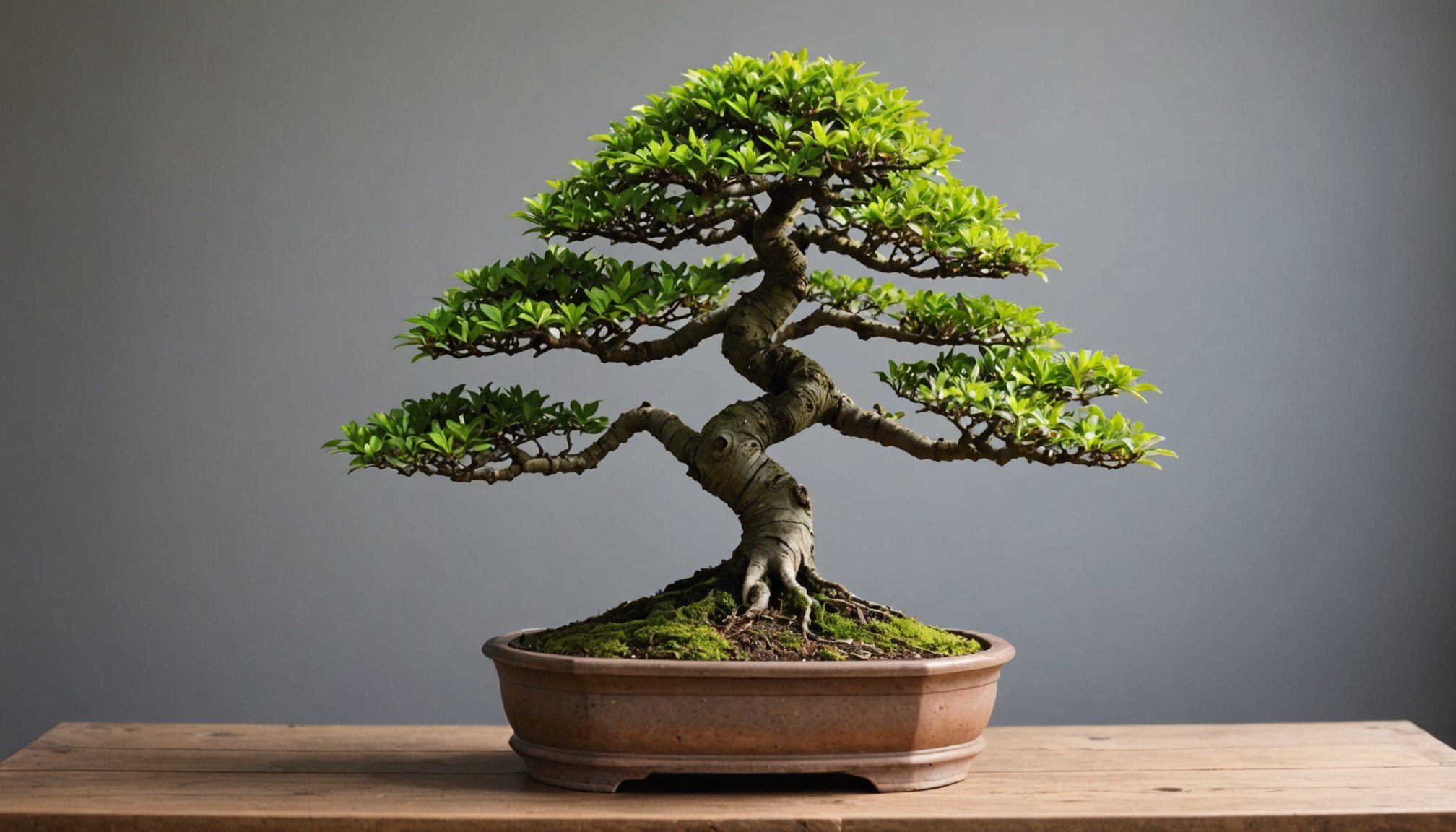Understanding Bonsai Trees and Their Significance
Bonsai trees are miniature trees that capture the beauty and essence of nature in a small, aesthetically pleasing form. Originating from ancient China over a thousand years ago, the art of bonsai was later refined in Japan, where it gained significant cultural relevance. The word “bonsai” itself means “planted in a container,” and this practice involves meticulously cultivating trees to achieve a specific shape and size.
Bonsai trees hold immense cultural significance across various traditions. In Japan, they symbolize harmony, balance, and timeless beauty. These qualities have made bonsai a representation of Zen Buddhist philosophy, embodying patience and meticulous care. Similarly, in Chinese cultures, bonsai trees are seen as symbols of peace and prosperity, reflecting ancient values and aesthetics.
Sujet a lire : Mastering Watering Techniques: Optimal Herb Garden Care for the UK”s Ever-Changing Summer
Northern UK enthusiasts have several varieties to choose from when it comes to bonsai cultivation. Tree species such as the Chinese Elm, Juniper, and Scots Pine are particularly well-suited to the local climate. These varieties thrive in cooler temperatures, allowing bonsai lovers in Northern UK to experience the joy and tranquility of bonsai gardening.
In essence, bonsai trees are not just horticultural pursuits; they are a fusion of nature, philosophy, and art, deeply rooted in cultural traditions. They offer an opportunity for personal reflection and connection to a more natural rhythm.
Cela peut vous intéresser : Essential Tips for Effectively Winterizing Your Northeast UK Pond
Environmental Considerations for Northern UK Homes
In the Northern UK, the climate can notably influence the growth and care of bonsai trees. The region is characterised by distinct climate considerations, including variable temperature and humidity, which both play crucial roles in maintaining a healthy bonsai.
Indoor and outdoor conditions for bonsai care diverge significantly. Indoors, maintaining consistent temperature and controlling humidity levels can help replicate the ideal environment these miniature trees require. It prevents stress from fluctuating conditions that might otherwise impact growth. Outdoors, bonsais must be shielded from harsh weather elements. Protective coverings or relocating them to sheltered areas can mitigate potential damage particularly during cold snaps known to the Northern UK climate.
Adaptations are essential, especially when managing seasonal changes. During winter, bonsai trees may need extra measures such as mulching or using insulating materials to protect roots against frost since Northern UK winters can be harsh. Meanwhile, in cooler summer months, additional sunlight exposure might be necessary to ensure adequate growth. Understanding these environmental aspects not only supports healthy growth but also prolongs the lifetime of bonsai trees within this specific climatic region.
Essential Care Tips for Bonsai Trees
Caring for bonsai trees involves several crucial steps to ensure their health and longevity. Understanding precise bonsai care techniques can make a significant difference in your plant’s vitality.
Watering Techniques
Consistent and proper watering is fundamental for any bonsai. The importance of consistent watering cannot be overstated, as these trees have little soil to retain moisture. Its small soil volume necessitates regular checks to avoid drying out. Best practices for checking soil moisture include using a moisture meter or simply placing your finger about an inch into the soil. If it feels dry, it’s time to water. Effective methods for watering involve gently pouring water until it drains out the bottom, ensuring all roots receive adequate hydration.
Fertilization Strategies
Fertilizing is another crucial aspect of bonsai care. Types of fertilizers suitable for bonsai include balanced formulas like NPK. The timing and frequency of fertilization should be during the growing season, usually every two to four weeks. Choices between organic vs. synthetic options depend on personal preferences; organic ones tend to release nutrients slowly, while synthetic fertilizers deliver quicker results.
Pruning and Shaping
To maintain a bonsai’s shape, regular pruning is necessary. Techniques for pruning, such as pinching new growth and trimming larger branches, help maintain both aesthetic form and tree health. Essential tools required for effective pruning include sharp shears and concave cutters, which prevent damage and support healing. Pruning importantly aids in guiding the tree’s energy to develop desired shapes and density.
Common Challenges and Solutions
Bonsai growing offers immense satisfaction, but beginners often face hurdles, especially with bonsai challenges like pests and diseases. Identifying these issues promptly ensures healthy growth.
Common Pests Affecting Bonsai Trees
The most frequent pests include spider mites, aphids, and scale insects. These tiny attackers can cause significant damage if unnoticed. Early detection involves inspecting leaves for webbing or sticky residues, which are common signs.
Preventive Measures and Treatment Options
Preventive measures are crucial. Regularly spraying leaves with water can thwart spider mites, while horticultural oils offer an effective deterrent against aphids and scale. For infestation, neem oil is an excellent natural remedy. Always quarantine new plants to avoid introducing pests.
Recognizing and Addressing Common Diseases
Fungal infections are leading among bonsai diseases. Leaf spots or wilting branches often signal issues like root rot or mildew. Proper watering habits and ensuring adequate sunlight prevent such diseases. Should your bonsai show symptoms, immediately prune affected parts and employ fungicides judiciously. Additionally, maintaining proper drainage reduces root rot risks.
By understanding and addressing these challenges head-on, bonsai enthusiasts can enjoy healthy and flourishing miniature trees, turning these puzzles into rewarding learning experiences.
Growth Strategies for Bonsai Success
Achieving bonsai success requires understanding and implementing effective growth strategies. Among these, wiring and repotting are crucial for shaping and maintaining the health of your bonsai trees.
Wiring Techniques
Wiring is a technique that allows enthusiasts to artfully shape their trees. The primary benefit is the creation of aesthetic forms by guiding branches into desired positions. To wire properly, begin by selecting the appropriate wire size – typically aluminium or copper – that is roughly one-third the diameter of the branch. Start at the trunk and wrap the wire at a 45-degree angle, moving outward. Ensure the wiring is snug but not so tight that it damages the bark. Avoidance of damage is key; regularly check for tightness as the tree grows.
Repotting Essentials
Repotting your bonsai is essential for health and growth. Signs that it’s time include slow growth and roots circling the pot. Best practices involve gently removing the tree, pruning roots to prevent overcrowding, and choosing well-draining soil. Repotting frequency generally ranges from yearly for younger trees to every 3-5 years for older ones.
Seasonal Growth Tips
Bonsai trees undergo distinct growth phases each season. In spring, they need increased watering and light. During summer, protect from intense heat but ensure enough sunlight. Autumn focuses on preparing the tree for dormancy, reducing watering, and providing shelter from frost. Tailoring light and temperature management to these phases enhances growth.
Resources for Bonsai Enthusiasts
For those involved in the bonsai gardening scene in Northern UK, accessing the right bonsai resources is key to cultivating your miniature trees. Starting with tools, every bonsai gardener should equip themselves with essentials like pruning shears, branch cutters, and root rakes. These tools ensure that plants are well-maintained and healthy, aiding in precise trimming and shaping.
When it comes to purchasing bonsai, several retailers in Northern UK stand out. Specialty shops such as Bonsai4Me and Green Dragon Bonsai provide a wide variety of bonsai trees and accessories suitable for differing expertise levels. They offer everything necessary for setting up and nurturing your bonsai garden. This makes shopping both convenient and efficient.
Connecting with fellow bonsai enthusiasts can also be invaluable. Engaging in online communities and forums, like the UK Bonsai Association forum, can provide support and ideas. Newbies and seasoned gardeners alike can exchange experiences, discuss challenges, and recommend bonsai resources. It’s a great way to stay inspired in your bonsai journey and continuously improve your skills. Thus, combining the right tools, purchasing from trusted retailers, and participating in online bonsai communities strengthens every enthusiast’s foundation in bonsai gardening.











